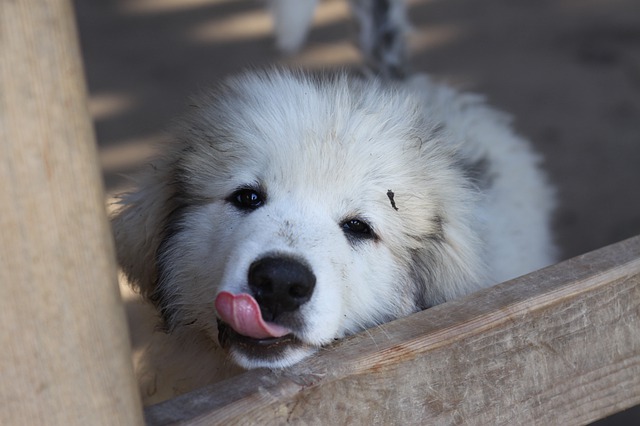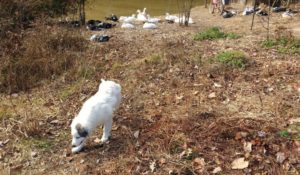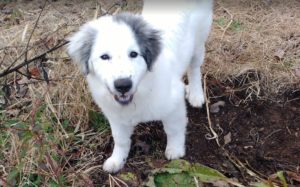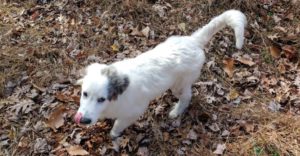A few minutes after I sat down to write this article on introducing dogs to livestock, my partner, Matt, came rushing into my office saying, “Luna has one of your ducks!” Luna is our 7-month-old Great Pyrenees puppy who is not yet mature enough to be trusted around poultry.
Needless to say, I had to put my writing on hold. Instead, I threw on my boots and raced out to see what could be done about the duck.
Sure enough, there sat my Pyrenees princess, with a beautiful (but dead) Muscovy female in her paws. Luna looked up at me with so much delight and pride. A silly-looking streak of blood smeared across her white furry face and the puppy gleam in her eye almost made me laugh.
Thankfully, the carcass (complete with ripped-off wing strewn a few feet away) kept me from giving into the urge. My big, beautiful Luna is a fine predator, to be sure. Problem is, she’s in training to be a livestock guardian dog.
Action had to be taken.
Luna’s First Lesson About Poultry
I stepped toward Luna, slowly and carefully. I didn’t want to alarm her or she’d grab her predator’s prize and race off out of reach. Once close enough, with swift action, I grabbed the duck from her and shoved it in her face while firmly saying, “No!”
I repeated this until Luna cowered in submission. Then, I sat the duck down in front of her and dared her with my mannerisms to take it. Luna looked at me and then backed away from the duck. I picked up the Muscovy and threw it down at her paws. Again, she backed away. I repeated this one more time, just to make sure she got the message: ducks are off-limits.
Finally, I picked up the dead duck and the ripped-off wing, turned my back on Luna, and walked back to the house to process the duck for dinner. (No sense in wasting the meat just because I hadn’t made the kill.)
The whole disciplinary transaction took less than 30 seconds. A longer scolding might have triggered defensive responses, rather than submissive responses, from my 65-pound puppy. And that would have meant my efforts had backfired.
You May Also Enjoy:
After I finished processing the duck, I put Luna on a leash and took her on a long walk. We ran and played together. I gave her a full-body doggy massage. Then I worked with her on a few of her skills like drop it (her toy), down (as in lay down), and come.
Scold Appropriately
For a scolding like the one I gave Luna to be effective, it must be rare. When used in the context of an otherwise friendly relationship and consistent training program, it can be a very useful tool. But let me be clear, scolding is not my go-to method for training a dog. It was simply called for in this circumstance.
The Truth About Dogs and Livestock
When this kill took place, Luna was in with my male goats. Those boys had already taught her to respect them by giving her a few head butts. They had also demonstrated their fierceness by rearing up on their hind legs in her general direction.
My smart girl had gotten their message and kept a humble distance. Even so, I supervised her visits with the goats for weeks to be sure I could trust her. I still watch her most of the time she is with them because she’s a puppy and her moods and motivations are in flux right now.
Also, I believed the goat pen had sufficient fencing to prevent Luna from gaining access to my free-range poultry. Otherwise I would not have left her unattended with poultry nearby.
Unfortunately, that poor duck flew into the goat pen to meet her end. That’s one of the many risks of free-ranging livestock. They get to make decisions about where they go. And you can’t protect them as completely as you can in confinement.
I hadn’t planned to give Luna a lesson on poultry yet. She still had too many uncontrolled puppy impulses to be ready for animals that were so naturally fearful of her. But since the opportunity presented itself, I took it.
Truth is, when you bring a new dog onto your farm, homestead, or house, you are risking the lives of all the other animals in your care.
Dogs are predators. This is a fact. Even dogs bred to protect animals, like guardian- or herding-type dogs, have inborn instincts to kill. These wonderful animals are descended from wolves, for goodness’ sake! Expecting dogs not to be natural predators is just plain silly.
The Difference Between Discipline and Anger
Because I knew it was my job to keep my livestock safe from my livestock guardian dog, I wasn’t upset with Luna. In fact, I never would have disciplined her at all if I didn’t have my anger in check.
Dogs are smart. If you discipline them for certain behaviors, they learn to fear the consequences of committing those behaviors. Alternatively, if you make your anger apparent every time they do something you don’t like, they just learn to fear your anger.
Since they can’t reason out what makes you angry, they start to fear you without learning what you expect of them. Do that long enough and your dog will become so submissive they’ll pee or cower every time you raise your voice. Or worse, a dominant dog might rebel and become dangerous.
Positive Training
Since that duck incident, I’ve decided to speed up Luna’s exposure to poultry for their safety. My new technique includes giving Luna her dinner. After she finishes it, I take her on a leash to stand near and watch while my ducks eat their dinner.
If she takes a step toward them, I say, “stay.” When she listens, I pet her behind the ears for a few seconds. If not, I pull her back into position. After a few seconds of good behavior, I pet her to encourage her to stay longer.
In just a few days, she’s gotten to the point where she sits happily next to me, barely noticing the ducks, for 4 whole minutes (a long time for a puppy). Even though she doesn’t need me to tell her stay anymore, I still pet her head about every 30 seconds to reinforce her good behavior.
After this, I take her on a long walk. I let her off leash in a safe area and throw a stick for her. We do this every day.
Tips on Training Dogs For Livestock Safety
I bet you have already figured out that my tale about Luna and the duck is loaded with tips on training dogs for use with livestock. Just for the sake of reinforcement, though, here are a few important takeaways from the story.
1. Assume All Dogs Want to Kill Your Livestock
Be prepared to protect your livestock from your dog until you are sure the dog understands his or her duties and responsibilities. Even then, know that accidents happen. For example, wounded or overly fearful livestock may trigger a trained dog’s latent predator instincts.
2. Positive Modeling is a Must
There is no perfect way to prepare a dog to work with livestock. Every dog has a different temperament and learning curve. Also, different kinds of livestock will trigger different responses in your dog.
Ideally, though, most training should be positive modeling of what you want from your dog rather than reactive anger over what you don’t want.
- Reward the behaviors you want with treats and love.
- Give much more attention to the correct behaviors than the inappropriate behaviors.
- Replace incorrect behaviors with correct behaviors (e.g., swap a chew for a shoe or chasing a ball for chasing a chicken).
- Create positive training experiences where your dog will succeed.
When negative training is necessary, such as scolding, make it quick and meaningful. Long, drawn-out scold fests turn on the defensive response in your dog. This makes them much more likely to challenge your authority in the future.
3. Set Dogs Up For Success
I started Luna off with my male goats, because I knew they would protect themselves. If she were already a 110-pound adult Great Pyrenees, they might not have been so assertive. But when I first introduced them, she was 35 pounds and short on self-confidence. The goats recognized this and worked quickly to ensure that she acknowledged their physical dominance.
Start Early
If you can start acclimating your dog to livestock at a young age, it’s easier to convince your puppy that livestock are to be respected. Generally, it’s believed that puppies have better bonding ability before 4 months of age. However, I know from experience that dogs can learn later in life, too.
Start with Assertive Livestock
Train your dog using livestock animals that are less likely to show fear. Strong males or herd/flock leaders make good choices for first introductions.
Livestock that are naturally fearful of dogs, like poultry, are more difficult to train your dog not to kill. Their flightiness and natural instincts to run automatically set off a dog’s predatorial instincts.
Personally, I think “good fences make good neighbors” when it comes to dogs and poultry. Using dogs to patrol outside the fence rather than live with the poultry works well. All other interactions, such as herding, are safer when supervised.
Exercise Caution During Puppyhood
In general, until your dog is fully mature, has been trained for duty, and has demonstrated extreme calm around livestock, supervision is going to be necessary. Puppyhood can last anywhere from ages 1-1/2 to 4, depending on the breed and particular dog.
Even with larger livestock, be aware that arousal biting, nipping, and other potentially predatorial behaviors can appear at any point during puppy development. If you don’t correct those behaviors immediately, they can become dangerous (refer to point 1 above).
4. Create Rituals Around Livestock Interactions
Successful dog training is partly about your dog’s aptitudes. But mostly, it’s about your skill as a trainer. Being consistent in your methods is critically important. I like to create rituals around my training exercises to make them more productive.
Following the same routine, doing mental preparation, and making sure your dog is primed for learning expedites results. For example, here’s my ritual for duck introductions (post-kill):
- I make sure I am calm and ready for the interaction. My dog is going to take cues from me, so I need to be in the right state of mind for telegraphing my calm, cool collectedness.
- I make sure my dog is well-fed before each livestock interaction.
- I only bring Luna to my livestock when they are occupied by other activities, like eating. That way, they’ll be less likely to notice her and won’t demonstrate fear.
- I start small. Puppies only have short attention spans. Rather than set impossible goals, I start with just 1–2 minute interactions and work up from there. (Eventually I plan to lay out a blanket, and then Luna and I will have a nice nap with the ducks.)
- I end the interaction with a reward. Usually this is a walk, since that’s a reward for me, too! But sometimes I only have time to throw a stick a few times or give my puppy a good massage.
5. Pay Attention to Body Language
As I said earlier, dogs are smart. They are even good at pretending weakness or contrition to lure you into trusting them. To make sure you don’t get duped, pay attention to your dog’s body language.
Observe their reactions to your livestock. Look for physical signs like ears perking up, tails standing erect, tightening around the mouth, and excessive alertness. These are all clear signs that your dog sees your livestock as prey.
If they immediately lunge at your livestock, that’s a clue that your dog has a very strong predator drive. But even those subtler body cues can mean you’ll have a lot of training to do to make your dog ready for use with livestock.
If your dog is genuinely relaxed at all times with your livestock, you may have lucked into a natural caretaker. However, that’s extremely rare, usually only presents itself in already mature dogs (like mothers), and still requires training to ensure long-term good behavior.
Conclusion
Dogs can help keep your farm safe from external predators. They can provide companionship to you and your other animals. They can also be endlessly entertaining. Personally, I can’t imagine life without them.
They do, however, require significant time and training when used with livestock. Make sure you are ready for that commitment. Then keep at it until you have the dog of your dreams!
What Do You Think?
Do you have any tips for or stories about training dogs to work with livestock? Share them with us in the comments below!

Tasha Greer is a regular contributor to The Grow Network and has cowritten several e-books with Marjory Wildcraft. The author of “Grow Your Own Spices” (December 2020), she also blogs for MorningChores.com and Mother Earth News. For more tips on homesteading and herb and spice gardening, follow Tasha at Simplestead.com.












COMMENTS(4)
Thanks for the valuable info. 🙂
Something else that you may find of interest is that donkeys are also natural defenders that won’t attack your livestock. They not only make a racket when a preditor approaches but they will try to defend.
There is even a donkey farm in Australia that specifically breeds donkeys for this purpose -to defend livestock. I don’t know how difficult it is to care for them, but they may be worth checking out as another alternative.
Cheers
Karen
Donkeys are great for predator protection. There are quite a few people in my area that keep them with horses or cows. Great suggestions as an alternative to LGDs. Thanks for reading!
We have a one year old Maremma female that we brought on our farm for predator protection. Livvy has been hard to train with our sheep and goats. We are no experts by far in training a guardian dog but do our best with information from friends, vets, and the internet.
Livvy loves to “play” with the barn cats and has even adopted one kitten as her own (now grown) but constantly barks at the others. This is not so much the problem we have but might be part of it.
We have a small flock/herd of sheep and goats. The goats pretty much have defended themselves and she leaves them alone. We had one incident when she was “picking on” a goat that was ill. We pulled her away from the flock so that she would not harm the goat. After the goat could defend herself there was less of a problem with that but Livvy would sometimes antagonize or tease the goat.
We also have a couple of sheep ewes that are five to six years old. She bothers one of them but not the other as much.
We only let Livvy be around them when we are there as we do not trust her. We introduced Livvy to the animals when she was about 5 months old. We also have a female llama in with the animals and she does not interrupt Livvy so not sure why she doesn’t protect them.
Maybe we are over protective and just need to let her be with the animals and let them work it out?
Any advice?
Thanks
JoAnn – Thanks for sharing your story. LGDs do most of their protecting simply by being large and barking at anything that’s not supposed to be with the herd. So, if she always barks at the other cats, it might be that she thinks they aren’t supposed to be there. You may want to make sure she knows the cats are welcome. She could also just be trying to get them to play so you may just need to direct her energy elsewhere. As far as the bad behavior towards some of the sheep and goats, I suggest you keep on correcting her so she doesn’t get confused about what’s acceptable. At 1 year old, I’m sure Livvy still has a lot of puppy in her. So she’s probably just mis-interpreting the less assertive responses from docile members of your herd as them agreeing to be her playmates. But, I bet with a few more months of working with her regularly so she understands they are are not playmates, she’ll stop trying. Also, sick animals can definitely bring out a predators kill instincts. So if possible, I would keep her away from any under the weather animals. Thanks for reading and good luck facing those last few training hurdles with Livvy!